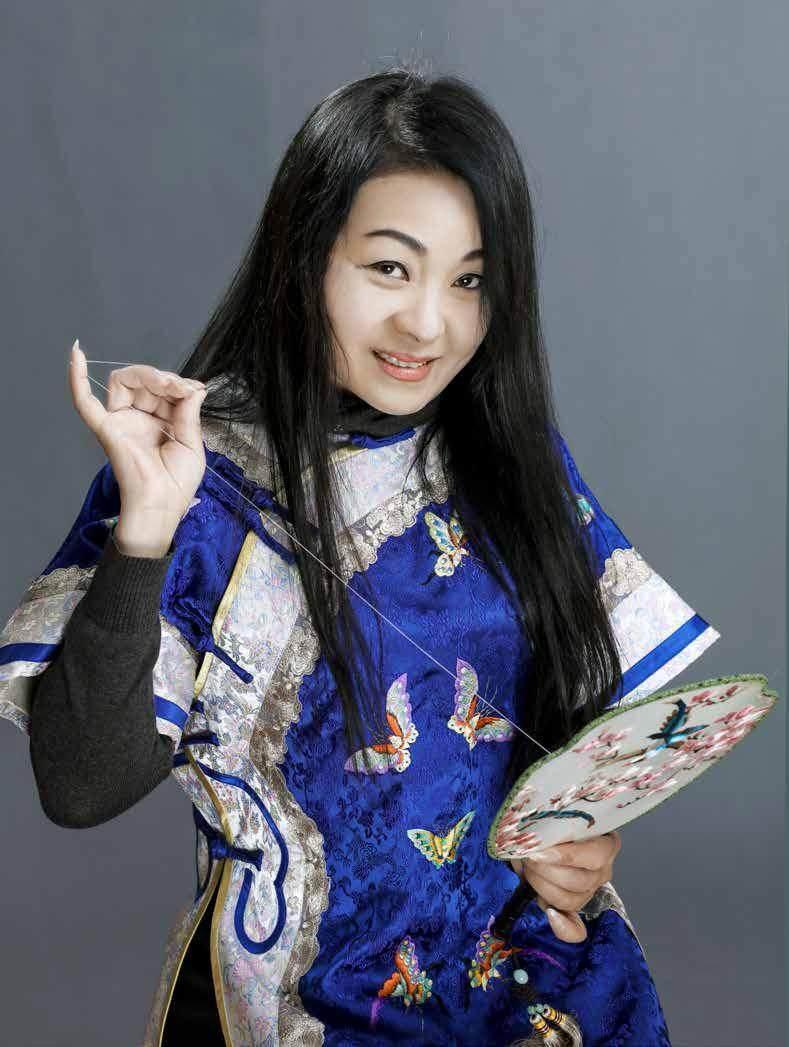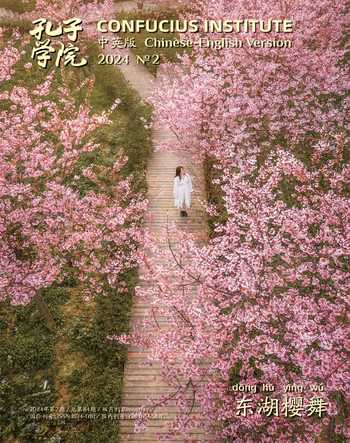怒放的汉绣之花Blossoming Han Embroidery
郭海燕Guo Haiyan



20世纪60年代末的一天,汉口头道街,一个名叫黄春萍的幼童瞥见奶奶在绣花。只见窗下头发花白的奶奶戴着眼镜,手持绣绷,将细线拉进、抽出。渐渐地,欢快跳跃的长尾鸟、五彩缤纷的蝴蝶就活脱脱地出来了,小春萍屏住呼吸,生怕惊飞那些鸟儿、蝶儿,她的两只小手还不停抚弄自己身上的棉布衣襟,那是奶奶和妈妈亲手缝制的,边边角角还绣上了令她喜爱不已的小花小草。这针线勾勒的美妙世界,实在太好看、太神奇了!
从此,黄春萍爱上了刺绣,并与之结下了不解之缘。In the late 1960s, on Toudao Street in Hankou,a young child named Huang Chunping watchedher grandmother practicing the art of embroidery.With silver hair and glasses, her grandmother heldan embroidery hoop, skillfully weaving thin threadsin and out. Before her eyes, vibrant long-tailed birdsand colorful butterflies came to life. Little Chunpingheld her breath, afraid of disturbing these exquisitecreations. Her tiny hands caressed the cottonfabric of her winter jacket, which was made by hergrandmother and mother and adorned with delicateflowers and grass that she adored. This enchantingworld, crafted with needles and threads, left herutterly spellbound. It was in that magical momentthat Huang Chunping fell in love with embroideryand formed a lifelong bond.
长大一点后,黄春萍才知道,中国有四大名绣——苏绣、蜀绣、湘绣、粤绣,它们又各有分支,如苏绣就有苏州刺绣、南通仿真绣、无锡精微绣、扬州刺绣等流派。那么,奶奶和妈妈的绣活儿,又属何门何派呢?原来它叫汉绣,自成一派。汉绣源于中国古代春秋战国时的楚绣,有2 500多年历史,是中国诸多绣种中唯一保持楚文化基因又融汇南北绣法之长的刺绣品类。
As she grew older, Huang Chunping discoveredthat China was home to four renowned embroiderystyles: Suzhou embroidery, Sichuan embroidery,Hunan embroidery, and Canton embroidery. Eachof them had its unique branches, like Suzhouneedlework, Nantongs realistic-style embroidery,Wuxis delicate embroidery, and Yangzhouneedlework. But what style did her grandmotherand mother practice? It turned out they werepractitioners of Han embroidery, a distinct stylerooted in the ancient Chu embroidery of the Springand Autumn Period and the Warring States Period inChina, with a history spanning 2,500 years. In fact,it is the only embroidery category in China that haspreserved the cultural essence of the Chu Kingdomwhile incorporating the finest techniques from bothnorthern and southern embroidery traditions.
作為一个地方绣种,汉绣以湖北荆州、洪湖、武汉为中心区域,其特点是采用“平金夹绣”,层层施色;画面层次分明、繁而不乱,色彩对比强烈,所绣图案可枝上生花、花上生叶、叶上出枝,光彩夺目,美不胜收。
As a regional style, Han embroidery is centeredaround Jingzhou, Honghu, and Wuhan in HubeiProvince. Its distinctive features include the use of“horizontal interlocking golden threads” to create agradation of colors. The resulting images are clear,intricate but not chaotic, with strong color contrasts.The embroidered patterns can depict flowers growingon branches, leaves sprouting from flowers, andbranches emerging from leaves, creating a dazzlingand breathtaking display of beauty.
黄春萍就在这浓厚的汉绣氛围里出生、长大。凭着对刺绣的热爱,这个大眼盈波、极有主见的武汉姑娘,10岁时就拜韩辉和项珍珍两位汉绣大师为师。学艺的日子里,她每天苦练12小时以上,手指常被刺破。当窗外小伙伴们玩得不亦乐乎时,她在绣架前一坐,从日出绣到日落,从不叫苦。
Huang Chunping was immersed in the richtradition of Han embroidery from a young age.With an unwavering passion for this art form, sheembarked on an apprenticeship under two masters,Han Hui and Xiang Zhenzhen, when she was just10 years old. Her days of learning were marked byrelentless practice, often resulting in pricked fingers.While her peers played outside with joy, HuangChunping devoted herself to her embroidery frame,working from sunrise to sunset without complaint.
真正的汉绣大师除了有一手好针线活儿,还必须会画画,懂设计——这可是刺绣的灵魂啊!于是,黄春萍勤奋读书,考取了武汉一所工艺美术学校,毕业后顺利進入当地一家绣花厂工作。1986年,21岁的她考取了广州美术学院,攻读服装设计专业。1990年,她学成归来,仍回原单位从事汉绣设计工作。由于种种原因,2001年,黄春萍工作十多年的绣品公司(其间绣花厂被改制成绣品公司)倒闭了。
Master y of Han embroider y requiresproficiency not only in needlework but alsoin drawing and design, whichare at its core. Thus, HuangChunping diligently pursued her studies and gainedadmission to a school of arts and crafts in Wuhan.After graduating, she joined a local embroideryfactory. In 1986, at the age of 21, she was admittedto the Guangzhou Academy of Fine Arts to major inclothing design. Following her graduation in 1990,she returned to her hometown and resumed her workin Han embroidery design at her original workplace.Unfortunately, in 2001, the factory, where HuangChunping had dedicated over a decade of her life,closed its doors for business (restructuring) reasons.
20世纪90年代以来,随着中国经济的发展,人们的生活水平不断提高,服装市场空前繁荣,汉派服装也逐渐兴起。“我那时就在汉正街上,很多服装店的老板要往衣服上刺绣,我就接了很多设计的活儿。图案一定下,我就组织工人们去刺绣,我自己也绣。订单量有大有小,至于报酬,是根据衣服上的刺绣图案来定:图案复杂的我们多赚点,简单的少赚点。那时,为了赶活儿,我常常一绣就是整个通宵。就这样,这条路一直走到现在……”说起这些,黄春萍的眼里闪着光,那是如丝线般柔韧、能容天地万物的光。一边接零活赚钱,一边照顾家庭,她继续用绣绷和绣架来实现自己的绣娘梦。几年下来,她积攒了数百幅汉绣作品。
In the 1990s, as Chinas economy flourishedand peoples living standards improved, therewas an unprecedented boom in the clothingmarket and a growing demand for traditionalHan-style attire. Reflecting on those times,Huang Chunping remarked, “Back then, onHanzheng Street, clothing stores were eager toincorporate embroidery into their garments. Itook on numerous design assignments. Afterfinalizing the designs, I would assemble a team todo the embroidery, and I would also personallycontribute. Order sizes varied, and compensationdepended on the intricacy of the embroiderydesign — more complex patterns brought inhigher earnings, while simpler ones earned less.To meet tight deadlines, I often worked throughthe night. That is how my journey in this fieldbegan and continues to this day...” As HuangChunping recounted her experiences, her eyesshone with a light as delicate as silk threads andas encompassing as the world. She supportedher family through piecework, all the whilenurturing her dream of becoming an embroideryartist, using her embroidery hoop and frame astools. Over time, she crafted hundreds of Hanembroidery pieces.
2008年春夏之交,黄春萍开始个人创业。她开了间汉绣工作室,即日后蜚声业内外的“锦绣坊”。
Around the summer of 2008, HuangChunping made the decision to establish her ownembroidery business. The studio she foundedwould later become known as the famous “JinxiuFang” (Splendid Workshop), both within andbeyond the industry.
工作室开张不久,某个中午,黄春萍感觉不对劲,怎么绣架像在动,地面也有点晃啊?晚上回到家,打开电视,她惊呆了:四川省汶川县发生大地震,7.8级(后震级修订为里氏8.0级)大地震!电视里的新闻滚动播放,震后场景惨不忍睹:楼房、道路、桥梁和通电、通水、通信设施等全垮了。黄春萍流着眼泪看新闻,蓦地,她的目光被电视上一帧画面深深吸引:北川中学倒塌后,一片废墟上,一面鲜红的国旗正静静飘扬在校园的上空……这面旗帜没倒啊!无数的解放军、武警部队官兵昼夜兼程赶赴灾区;一批批消防官兵、特警、公安民警等千里驰援;还有全国各地的志愿者、各种支援疾奔汶川……大灾大难之时,我们的五星红旗没倒,民族精神还在!黄春萍的眼睛一亮,学美术出身、对画面敏感的她,一下子來了创作灵感。她浑身热血沸腾,决定以此为原型,用刺绣来展现中国人民面对一切困难的顽强不屈。
Not long after her studio opened, one afternoon,Huang Chunping sensed something unusual. Theembroidery frame seemed to be moving, and the groundbeneath her feet slightly swayed. When she returnedhome that evening and turned on the television, shewas left in shock: a massive earthquake measuring7.8 on the Richter scale (later revised to 8) had struckWenchuan County, Sichuan Province! The imagescontinuously scrolled on TV, playing heart-wrenchingscenes post-earthquake: buildings, roads, bridges, and essential utilities like electricity, water, andcommunication had all crumbled. Tearswelled up in Huang Chunpings eyes asshe watched the news coverage. Suddenly,her eyes were drawn to an image on thetelevision: amidst the ruins of BeichuanMiddle School, a vivid red flag proudlyfluttered in the sky... the flag hadnt fallen!Thousands of members of the PeoplesLiberation Army and armed police forcesrushed to the disaster area day and night;teams of firefighters, special forces, and policeofficers traveled great distances to provideaid; volunteers from across China came to Wenchuan... in the face of this catastrophe, Chinasfive-starred red flag stood tall, and the spirit of the nation persevered! Huang Chunpings eyeslit up. As an art graduate with a keen visual sense, inspiration struck her instantly. Filled withpassion, she decided to use her embroidery skills to portray the unwavering spirit of the Chinesepeople in the face of adversity.
此时的黄春萍已练就过人的本领。针线不离手,美术、服装设计专业出身的她,历经30多年实践,将传统汉绣与现代书法、绘画、篆刻、陶瓷等艺术技法相融合,形成了独具特色的个人艺术风格:似绣非画,似画非绣。她想将自己的绝活儿一股脑儿地展现在这幅震后的国旗作品上。自2008年5月20日起,黄春萍心无旁骛,全身心投入该作品的创作之中。她融合汉绣、苏绣、湘绣等多种刺绣手法,通过线条粗细对比,来营造自然、虚实相间的立体感;利用针法排列角度和方向的变化,来呈现刺绣特有的丝光效果。最终,她耗时整整一年,用568万针、800余种色线,完成了近1平方米的心血之作:《 屹立的国旗》。此作远观真实生动,近看出神入化。见者无不凝神。更令人称奇的是,作品传达的主题“坚强的国度,不倒的民族魂”呼之欲出,无声胜有声! 2009年,《屹立的国旗》毫无悬念地获得中国民间文艺最高奖“山花奖”,这也是湖北省迄今为止唯一获此殊荣者。这幅作品被捐献给汶川县,被汶川博物馆永久珍藏。她本人则被授予“汶川县荣誉市民”称号。
At this point, Huang Chunping had already mastered exceptional embroidery skills.With needles and threads always by her side, she, a graduate in fine arts and fashion design,had accumulated over three decades of practical experience. By blending traditional Chineseembroidery with contemporary techniques such as calligraphy, painting, engraving, andceramics, she had developed a distinct artistic style that was neither purely embroiderynor merely painting. Her goal was to express all her knowledge of embroidery through a Chinese national flag artwork in the aftermath ofthe earthquake. Starting on May 20, 2008, HuangChunping dedicated herself to this project. Sheincorporated various techniques, including Han,Suzhou, and Hunan embroidery. By adjusting threadthickness, she achieved a natural, three-dimensionaleffect. Fine-tuning the angle and direction ofstitching, she created the unique silk-like shine ofembroidery. After an entire year of relentless effort,she completed her labor of love: “The Resilient Flag,”covering nearly one square meter, consisting of 5.68million stitches, and utilizing over 800 differentthread colors. When viewed from a distance, thework appeared lifelike, and up close, its detailswere awe-inspiring. Anyone who laid eyes on itcouldnt help but be captivated. What was even moreastonishing was the message it conveyed, “A StrongNation, an Indomitable Chinese Spirit,” palpablewithout the need for words. In 2009, “The ResilientFlag” unsurprisingly received the “Shanhua Award,”Chinas highest honor in folk art, making HuangChunping the sole recipient from Hubei Provinceto date. She later donated this artwork to WenchuanCounty, where it now resides permanently in theWenchuan Memorial. As a result of her contribution,Huang Chunping was granted the title of “HonoraryResident of Wenchuan County.”
2008年起,黃春萍开始带教残疾人弟子。2010年开始,在残联、妇联及其他相关部门的支持下,她每年开办培训班,通过“汉绣工厂”“楚凤起航”“黄鹤工坊”等项目,免费教授广大妇女特别是残疾人妇女汉绣技艺。经过十余年的运营,她们已逐步实现“设计—生产—销售—客户—市场数据反馈—设计”的闭环运营模式,十余家门店和生产基地遍布江城,年产值超千万元,市场地位稳固。
Starting in 2008, Huang Chunping embarkedon a journey to teach embroidery to people withdisabilities. By 2010, with the support of organizationssuch as the Disabled Persons Federation and theWomens Federation, she initiated free workshopson the art of Han embroidery. These workshops,titled “Han Embroidery Factory,” “Chu PhoenixTakes Flight,” and the “Yellow Crane Workshop,”placed particular emphasis on empowering women,especially those with disabilities. Over more than adecade, these workshops have successfully establisheda self-sustaining cycle that encompasses design,production, sales, and customer feedback. They haveexpanded to include more than a dozen stores andproduction facilities in Jiangcheng, with an annualoutput value exceeding tens of millions of RMB,firmly establishing their presence in the market.
2019年秋,武汉迎来第七届世界军人运动会。这是继2008年北京奥运会后中国举办的规模最大的国际体育赛事,来自100多个国家的近万名运动员参赛。为了寻找设计灵感,将世界军运文化和长江文化、湖北荆楚文化、武汉城市文化相融合,黄春萍专程前往三峡等地参观、写生。最终,她和团队歷时两年多,创作出50余幅军运会主题作品。“此次军运会不仅是国际性的体育盛会,更是世界性的文化交流盛会,我希望将东道主武汉特有的文化内涵传递给各国友人,为传承和发扬中华非遗文化作一点贡献。”黄春萍做到了,这批汉绣精品果真令各国运动员和嘉宾们惊叹不已!
In the fall of 2019, Wuhan hosted the 7th CISMMilitary World Games, a momentous internationalsporting event comparable in scale to the 2008Summer Olympics in Beijing. Nearly ten thousandathletes from over 100 countries converged inWuhan for the occasion. Seeking inspiration, HuangChunping traveled to locations like the Three Gorges,where she meticulously observed and sketched thecultural elements of the Military World Games,the rich heritage of Hubei, and the vibrant urbanlife of Wuhan. Over two years, she and her teamcrafted more than 50 artworks with the MilitaryWorld Games theme. “The Military World Gamestranscends being a mere international sporting event;its also a global cultural exchange event. My missionis to convey the cultural essence of Wuhan, the hostcity, to friends from all corners of the world andcontribute to the preservation and dissemination ofChinas intangible cultural heritage,” stated HuangChunping. Indeed, the exquisite Han embroiderymasterpieces she created left athletes and guests fromacross the globe in sheer awe!
自2019年以来,黄春萍还陆续在湖北十堰房县、咸宁赤壁等地设立“中国非遗文化黄春萍汉绣艺术精准扶贫基地”“汉绣产业发展乡村振兴基地”,并同当地建档立卡户妇女结对子,为数千人提供汉绣技能培训,同时还引领无数贫困妇女、留守妈妈按市场订单进行创作、生产,帮助她们实现就业增收。
Since 2019, Huang Chunping has been activelyestablishing the “Huang Chunping Han EmbroideryArt Targeted Poverty Alleviation Base” and the “HanEmbroidery Industry Rural Revitalization Base” inFangxian County in Shiyan City and Chibi Countyin Xianning City. Collaborating with local womenfrom underprivileged households, she has providedHan embroidery training to thousands of individuals.Moreover, she has guided numerous disadvantagedwomen and stay-at-home mothers in designing andmaking market-driven products, helping them secureemployment and increase their income.
2020年春,一场前所未见、突如其来的疫情来袭,武汉“女将”黄春萍再次组织团队,以我心绣众志成城之心,创作出汉绣筷套、抗疫香囊、抗疫口罩等系列产品,即便力微如斯,亦助家园战胜疫情。
In the spring of 2020, when an unprecedentedand unexpected pandemic swept through Wuhan,Huang Chunping once again rallied her team todevelop various themed pieces, including Han embroidery chopstick holders, anti-pandemic sachets, and face masks. Despite havinglimited resources, they exhibited a collective determination to mitigate the pandemicsimpact.
国家级非物质文化遗产汉绣制作技艺代表性传承人,中国民间文艺最高奖“山花奖”得主,汶川县荣誉市民…… 一项项荣誉的背后是汗水、是坚持、是信仰、是责任,黄春萍用指尖传承汉绣技艺,穿针引线绘制幸福画卷,为抢救和保护、传承与发扬“楚文化大使”汉绣艺术,默默奉献努力着。
Today, Huang Chunping is widely recognized as a representative inheritor of Chinasnational intangible cultural heritage, a recipient of the prestigious Shanhua Award, andan honorary resident of Wenchuan County. Behind each of these honors lies a story ofhard work, unwavering dedication, deep faith, and a strong sense of responsibility. Withher skilled fingertips, Huang Chunping continues to carry forward the legacy of Hanembroidery, weaving a tapestry of happiness with her needles and threads. Seeing Hanembroidery as the Cultural Ambassador of Hubei, she remains committed to preserving,safeguarding, inheriting, and promoting this art form.
供图/ 郭海燕
——汉绣

